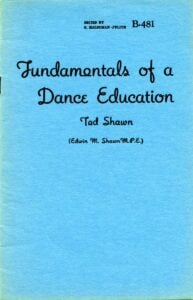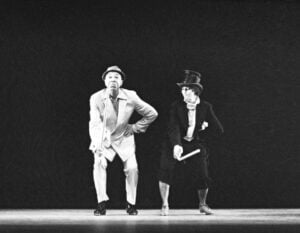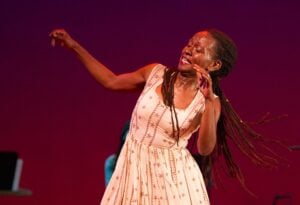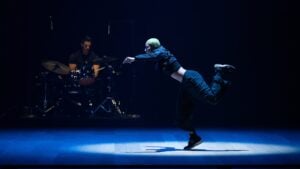Tap dance has had a long–and slightly tumultuous–history at Jacob’s Pillow. Emerging from obscurity, tap went from being largely absent from the Pillow for decades to flourishing across multiple stages, within The School and the Pillow Lab residency program, and now a main fixture of Festival 2025. In celebration of National Tap Dance Day on May 25, a day that also marks the birthday of tap pioneer Bill “Bojangles” Robinson, we’re led by Pillow Scholar and New York Times dance critic Brian Seibert through the winding history of tap at Jacob’s Pillow, and the icons that have brought us to today.
Seibert, a dance historian and author of What the Eye Hears: A History of Tap Dancing, has contributed several essays on tap dancing at the Pillow to Jacob’s Pillow Dance Interactive, one of which being a comprehensive history. His essay, “Roll Over, Ted Shawn: Tap at Jacob’s Pillow,” reveals the lesser-known beginnings of tap in the early decades of the Festival.

“Shawn held systematically developed views about every kind of dance, and he was far from shy about asserting them,” Seibert writes. “In his 1937 book Fundamentals of a Dance Education, he railed against tap as “an invention of the devil.””
Seibert explains that Shawn’s reasoning was wrapped in a complex and nuanced web of taste, cultural, and racial hierarchies that pervaded the entertainment and art worlds in the first half of the 20th century in the United States, in which tap and other African diasporic dance forms were not considered “high art.”
Following Shawn’s death in 1972, tap was incrementally folded into the Pillow’s programming by subsequent Artistic Directors, beginning with Jane Goldberg who performed with cheeky but masterful technique alongside veteran tap icons Charles “Cookie” Cook and Leslie “Bubba” Gaines, in 1978.

1983 brought with it the Pillow debut of Jazz Tap Ensemble, a company “in the vanguard of a new phase in the history of tap dancing,” as Brian Seibert writes in his essay highlighting the group’s history. Companies like Jazz Tap Ensemble were ushering in a new era of tap dance which began to increasingly occupy the concert stage in the 1980s, especially at Jacob’s Pillow.

When Jazz Tap Ensemble returned in 1993, a new generation of tap icons was emerging, and Derick K. Grant and Dormeshia were now among their ranks. In his essay on Dormeshia, Seibert writes:
“Prodigies don’t always grow into great artists, but in this case, the remarkable poise and rhythmic accuracy she demonstrated as a teenager were true portents of the extraordinary tap dancer she would become, frequently cited by her awed peers as the best in her generation, an artist so singular as to be known by her first name only.”
Derrick K. Grant and Dormeshia would continue growing their partnership at Jacob’s Pillow, joined by Michelle Dorrance in 2013 as the three-person choreographic team of The Blues Project by Dorrance Dance. The dynamic show performed to original blues music by Toshi Reagon brought the “cultural gumbo of tap” to the stage, featuring West African dance and Appalachian flat-footing.

These three singular artists–Derrick K. Grant, Dormeshia, and Michelle Dorrance–return to the Pillow this summer to continue to push the boundaries of tap dance boldly into the future. Michelle Dorrance, in collaboration with Ephrat Asherie, presents The Center Will Not Hold: A Dorrance Dance Production in an electric opening week of Festival 2025 in the Ted Shawn Theatre from June 27–29. A celebration of movement, rhythm, and sound, The Center Will Not Hold brings together an orchestra of regional music and movement, from tap dance and hip hop to breaking, house, Chicago footwork, Detroit jit, litefeet, Memphis jookin’, and body percussion.

Derrick K. Grant and Dormeshia will bring together the tap dance pioneers of the next generation in The School as program directors of the Tap Dance program. Together, Grant and Dormeshia will create experiences that honor tradition, pay homage to the pioneers, and celebrate the possibilities of now, culminating in a performance on the Henry J. Leir Stage on August 16.
In Festival 2025, Dorrance, Grant, and Dormeshia will be joined by Orlando Hernández, “a onetime tap prodigy who’s grown into a history-mining experimentalist” (The New Yorker) on July 24 and Michela Marino Lerman, recognized by Downbeat Magazine as “jazz’s premier tap dancer,” from August 8-9. With the rhythms of tap dance filling every venue and studio this summer, we’re reminded of how the Pillow’s stages, now far from silent, will continue to flourish with this art form for years to come.
This Pillow Pick was written by Lucy Kudlinski and published on May 23, 2025.
Explore More Tap Icons in the Archives
Feel the Rhythms This Summer
From "The Center Will Not Hold," an electric Dorrance Dance production, to the experimental tap of Orlando Hernández, feel the rhythms in Festival 2025.
